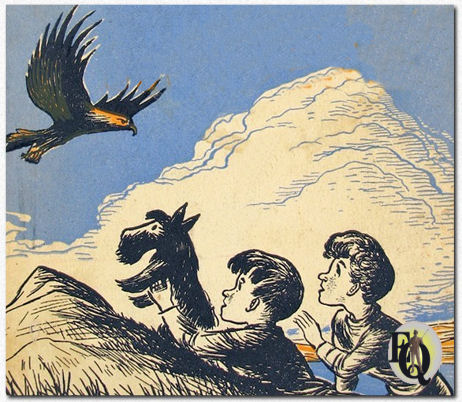
 |
![]()
 ''Ellery Queen is one of the world’s finest detectives, but his adventures are nothing compared to the Ellery Queen Jr. Mystery Stories. Join Queen’s apprentice, Djuna, and his trusty Scottie, Champ, on adventures filled with danger, suspense, and thrills.'' Since all of the juveniles were ghostwritten, for a long time authorship remained a close-kept secret. We do know Lee edited the books. Ghostwriters James Holding aroused the ire of Lee by farming out the writing of at least one book to a "sub-ghost". This practice has made establishing authorship even worse. Pulp fiction writer Frank Belknap Long (1901-1994) has admitted writing at least two, unfortunately, without mentioning the titles. Mike Nevins, and in his wake half the internet, identified them as The Golden Eagle Mystery and The Green Turtle Mystery. We do know Samuel (Duff) McCoy (1882-1964) had a contract with Lee/Dannay for each of the first eight juveniles from The Black Dog Mystery until The Blue Herring Mystery but he didn't actually write the stories ...
Whilst
researching his new book on
Ellery Queen, Jeffrey Marks found a
first edition of The Red
Chipmunk Mystery with the following
inscription "Rhinebeck, N.Y.
Aug. 31/48 For Karen Rose from
the only real ghost who had
anything to do with this book -
Harold Montanye".
He looked into this and found
proof in correspondence between
McCoy and Montanye that all final six books before
1954 beginning
with The Green Turtle
Mystery were written by Montanye. The Djuna series was reprised by Holding in 1966 with The Purple Bird Mystery. The interruption in the series between 1954 and 1966 probably explains why the ninth (and last) title is harder to find. The copyright entry for The Purple Bird Mystery mentions "David Hodges & others" (aside from Lee and Dannay). However David Hodges was responsible for the drawings in this book. Most likely this last book in the series is the only writing Holding contributed to the Junior series aside from the manuscript for The Silver Llama Mystery, which, although Dannay revised it, was never published.
|


|
Radio script adaptations Since the publication of The Tragedy of Errors (1999), which featured some uncollected stories, the only short stories which were never compiled are these radio script adaptations. |
|
|
|
|
Said to have been more Manfred's doing. Over the years several 'true crimes" were published in American Weekly, an insert in several journals. Written especially for The American Weekly. Initially they started with elaborate descriptions from the "Case Book Of True Mysteries" soon to be followed by series of more "fictionalized" reports of true events. Several distinct series are to be recognized. "The Big City Police Files" (done by several authors) is one of the first, soon followed by "Ellery Queen's International Crime File" . This series had cases which "... have been drawn both from official archives and confidential sources. Mr. Queen usually conceals key identities under fictitious names but in this article, because the case is a well-know and recent one, he has not done so." The best of them were compiled into International Casebook (1954-55).
The last series wasn't collected as such, published under the header "Masterpieces of Crime Detection" some stories were included in the previous collection. |
|
|
"Death
of a Don Juan" "The
Taylor Case"
(The Murder Hollywood Can't Forget)
"The Grammer Case"
(a
fascinating look at a famous murder)
"The Lake Palourde Case"
"The Case
of Terror in Texas"
"The Lethal
Lady"
"Mrs. Holmes Solves A Murder"
"The Black Swan Murder
Case" "The Love Slaves Orissa" "Mystery of the Crambling Road" "Murder in Lovers' Lane" "The Two-Way Clue" "Murder
at the Tea Party" "Dream
Cottage Murder"
"Crimes
of Passion" "Murder
After Forty" "The Terrible Avenger of Karos Island" "The Persistent Killer" "The Girl Who Went
Too Far" "The Trail of Broken Hearts" "Murder over Mt.Torment" "The Wife Who Wouldn't
Let Go" "4 Short Cuts To Love" "The Body in Trunk" "Why These Boys Killed Their Father" "The Strange Case Of Napoleon Caproni" "10 Graves for the Pretty Widow" "The Tennis Racket Murder" "The Diabolical Lover" "The Strange Case of the Mad Sculptor"
"The Friendly Killers" "The
Girl Who Had Never Been Kissed" "The Murder in the Underground"
"Sence of Guilt"
"Love at Second Sight"
"The Girl Who Wouldn't Go Steady"
"Till Death did them Part"
"Who blew up Mr. Smith?" "Death
of a Playboy"
"Love in the Death House"
"The Clue of the Missing Hands"
"Two Routes to Murder" "Murder In The Cabbage Patch" "The Clue Of The Naughty Word"
"The Body in the Bathtub"
"Double Jeopardy"
"Clue of the Foxtail Grass"
"Clue of the Shattered Watch" "The Hunt for the Phantom Gunman" "The Baby-Sitter Murder" "Murder with 18,000 Suspects" "Murder by Proxy" "The Red Herring Murder"
"The Firebug Murders" "The Clue in the Wallet" "Album of Death" |
|
 |
|
|
Others... "More than 16 years
have elapsed since the fateful night Bahamian multimillionaire Sir Harry
Oakes was brutally murdered in his bed. Since then, the suspected murderer's
name has been whispered frequently about the island resort although its
bearer has never been arrested, detained, or even publicly accused of the
crime. Family Weekly commissioned famous mystery writer
Ellery Queen to investigate the strange events surrounding this
baffling crime."
"The Killer Who Had Body
Ardor"
"Sweet Assassins’ and the Liberation,"
|
|
|
|
|

|
|
|
Introduction |
Floor Plan | Q.B.I. |
List of Suspects | Whodunit?
| Q.E.D. | Kill as
directed | New |
Copyright Copyright © MCMXCIX-MMXXIV Ellery Queen, a website on deduction. All rights reserved. |